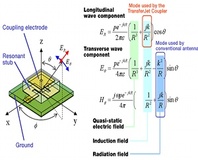
If you're tired of unreliable WiFi connections but still want to do your browsing sans wires, the common light fitting might offer some hope for the future.
According to Cellular News, a team at Boston University's College of Engineering is currently working on the ability to use LED lighting as a data communication channel, removing the need for a tethering wire while cleaning up the radio-frequency spectrum at the same time.
Professor Thomas Little paints a picture of a world where “your computer, iPhone, TV, radio and thermostat could all communicate with you when you walked in a room just by flipping the wall light switch and without the usual cluster of wires,” - so far, so WiFi. Where the project differs is in the use of visible light rather than radio waves: Little describes the system as “an LED-based communications network that also provides light - all over existing power lines with low power consumption, high reliability and no electromagnetic interference. Ultimately, the system is expected to be applicable from existing illumination devices, like swapping light bulbs for LEDs.”
While the project could feasibly work, there's a certain amount of assumption involved here: firstly, that we “switch from incandescent and compact florescent lighting to LEDs in the coming years” as a ubiquitous source of LED-based lighting is necessary for the system to work; secondly, that we're happy to have said LED lights turned on during the day.
While the speeds currently offered by the system – a projected 10Mb/s for the early generations – aren't anything to get excited about it's a system that certainly shows promise. Whether it would ever tempt anyone away from the now nearly ubiquitous radio-frequency based wireless networking technologies will remain to be seen – although the increased privacy available by simply drawing your curtains might have the paranoiacs enjoying wireless networking for the first time.
Would you be tempted by visible-light networking, or is it wireless networking already solved by current RF-based technologies? Share your thoughts over in the forums.
According to Cellular News, a team at Boston University's College of Engineering is currently working on the ability to use LED lighting as a data communication channel, removing the need for a tethering wire while cleaning up the radio-frequency spectrum at the same time.
Professor Thomas Little paints a picture of a world where “your computer, iPhone, TV, radio and thermostat could all communicate with you when you walked in a room just by flipping the wall light switch and without the usual cluster of wires,” - so far, so WiFi. Where the project differs is in the use of visible light rather than radio waves: Little describes the system as “an LED-based communications network that also provides light - all over existing power lines with low power consumption, high reliability and no electromagnetic interference. Ultimately, the system is expected to be applicable from existing illumination devices, like swapping light bulbs for LEDs.”
While the project could feasibly work, there's a certain amount of assumption involved here: firstly, that we “switch from incandescent and compact florescent lighting to LEDs in the coming years” as a ubiquitous source of LED-based lighting is necessary for the system to work; secondly, that we're happy to have said LED lights turned on during the day.
While the speeds currently offered by the system – a projected 10Mb/s for the early generations – aren't anything to get excited about it's a system that certainly shows promise. Whether it would ever tempt anyone away from the now nearly ubiquitous radio-frequency based wireless networking technologies will remain to be seen – although the increased privacy available by simply drawing your curtains might have the paranoiacs enjoying wireless networking for the first time.
Would you be tempted by visible-light networking, or is it wireless networking already solved by current RF-based technologies? Share your thoughts over in the forums.

MSI MPG Velox 100R Chassis Review
October 14 2021 | 15:04








Want to comment? Please log in.